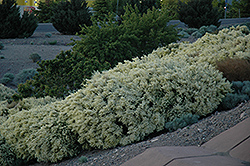It's all about ...
plants

Height: 4 feet
Spread: 4 feet
Sunlight:
![]()
Hardiness Zone: 6b
Other Names: Warminster Broom
Description:
An absolutely stunning low shrub when in bloom, with upright arching branches smothered in white flowers in late spring; somewhat diminutive the rest of the year but not unattractive; extremely tough and durable, tolerant of dry conditions
Ornamental Features
White Broom is smothered in stunning white pea-like flowers along the branches in late spring. It has grayish green deciduous foliage. The compound leaves do not develop any appreciable fall colour. The smooth bark and grayish green branches add an interesting dimension to the landscape.
Landscape Attributes
White Broom is an open multi-stemmed deciduous shrub with a shapely form and gracefully arching branches. Its relatively fine texture sets it apart from other landscape plants with less refined foliage.
This is a high maintenance shrub that will require regular care and upkeep, and should only be pruned after flowering to avoid removing any of the current season's flowers. It has no significant negative characteristics.
White Broom is recommended for the following landscape applications;
- Mass Planting
- Border Edging
- General Garden Use
Planting & Growing
White Broom will grow to be about 4 feet tall at maturity, with a spread of 4 feet. It tends to fill out right to the ground and therefore doesn't necessarily require facer plants in front. It grows at a medium rate, and under ideal conditions can be expected to live for approximately 20 years.
This shrub should only be grown in full sunlight. It prefers dry to average moisture levels with very well-drained soil, and will often die in standing water. It is considered to be drought-tolerant, and thus makes an ideal choice for xeriscaping or the moisture-conserving landscape. It is particular about its soil conditions, with a strong preference for clay, alkaline soils, and is able to handle environmental salt. It is highly tolerant of urban pollution and will even thrive in inner city environments. This particular variety is an interspecific hybrid.
This plant is not reliably hardy in our region, and certain restrictions may apply; contact the store for more information.
